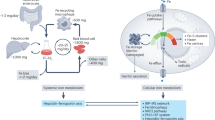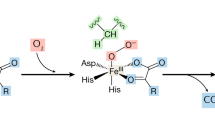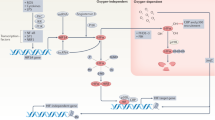Abstract
Hypoxia stimulates erythropoiesis, the major iron-utilization pathway. We report the discovery of a conserved, functional iron-responsive element (IRE) in the 5′ untranslated region of the messenger RNA encoding endothelial PAS domain protein-1, EPAS1 (also called hypoxia-inducible factor-2α, HIF2α). Via this IRE, iron regulatory protein binding controls EPAS1 mRNA translation in response to cellular iron availability. Our results uncover a regulatory link that permits feedback control between iron availability and the expression of a key transcription factor promoting iron utilization. They also show that an IRE that is structurally distinct from, for example, the ferritin mRNA IRE and that has been missed by in silico approaches, can mediate mechanistically similar responses.
This is a preview of subscription content, access via your institution
Access options
Subscribe to this journal
Receive 12 print issues and online access
$189.00 per year
only $15.75 per issue
Buy this article
- Purchase on Springer Link
- Instant access to full article PDF
Prices may be subject to local taxes which are calculated during checkout






Similar content being viewed by others
References
Eckardt, K.U. & Kurtz, A. Regulation of erythropoietin production. Eur. J. Clin. Invest. 35 Suppl. 3, 13–19 (2005).
Leung, P.S., Srai, S.K., Mascarenhas, M., Churchill, L.J. & Debnam, E.S. Increased duodenal iron uptake and transfer in a rat model of chronic hypoxia is accompanied by reduced hepcidin expression. Gut 54, 1391–1395 (2005).
Wang, G.L., Jiang, B.H., Rue, E.A. & Semenza, G.L. Hypoxia-inducible factor 1 is a basic-helix-loop-helix-PAS heterodimer regulated by cellular O2 tension. Proc. Natl. Acad. Sci. USA 92, 5510–5514 (1995).
Ema, M. et al. A novel bHLH-PAS factor with close sequence similarity to hypoxia-inducible factor 1alpha regulates the VEGF expression and is potentially involved in lung and vascular development. Proc. Natl. Acad. Sci. USA 94, 4273–4278 (1997).
Flamme, I. et al. HRF, a putative basic helix-loop-helix-PAS-domain transcription factor is closely related to hypoxia-inducible factor-1 alpha and developmentally expressed in blood vessels. Mech. Dev. 63, 51–60 (1997).
Hogenesch, J.B. et al. Characterization of a subset of the basic-helix-loop-helix-PAS superfamily that interacts with components of the dioxin signaling pathway. J. Biol. Chem. 272, 8581–8593 (1997).
Tian, H., McKnight, S.L. & Russell, D.W. Endothelial PAS domain protein 1 (EPAS1), a transcription factor selectively expressed in endothelial cells. Genes Dev. 11, 72–82 (1997).
Wenger, R.H. & Gassmann, M. Oxygen(es) and the hypoxia-inducible factor-1. Biol. Chem. 378, 609–616 (1997).
Schofield, C.J. & Ratcliffe, P.J. Oxygen sensing by HIF hydroxylases. Nat. Rev. Mol. Cell Biol. 5, 343–354 (2004).
Kallio, P.J., Wilson, W.J., O'Brien, S., Makino, Y. & Poellinger, L. Regulation of the hypoxia-inducible transcription factor 1alpha by the ubiquitin-proteasome pathway. J. Biol. Chem. 274, 6519–6525 (1999).
Lando, D., Peet, D.J., Whelan, D.A., Gorman, J.J. & Whitelaw, M.L. Asparagine hydroxylation of the HIF transactivation domain a hypoxic switch. Science 295, 858–861 (2002).
Semenza, G.L. Hypoxia-inducible factor 1: oxygen homeostasis and disease pathophysiology. Trends Mol. Med. 7, 345–350 (2001).
Hu, C.J., Wang, L.Y., Chodosh, L.A., Keith, B. & Simon, M.C. Differential roles of hypoxia-inducible factor 1alpha (HIF-1alpha) and HIF-2alpha in hypoxic gene regulation. Mol. Cell. Biol. 23, 9361–9374 (2003).
Warnecke, C. et al. Differentiating the functional role of hypoxia-inducible factor (HIF)-1alpha and HIF-2alpha (EPAS-1) by the use of RNA interference: erythropoietin is a HIF-2alpha target gene in Hep3B and Kelly cells. FASEB J. 18, 1462–1464 (2004).
Smith, K. et al. Silencing of epidermal growth factor receptor suppresses hypoxia-inducible factor-2-driven VHL−/− renal cancer. Cancer Res. 65, 5221–5230 (2005).
Hentze, M.W., Muckenthaler, M.U. & Andrews, N.C. Balancing acts: molecular control of mammalian iron metabolism. Cell 117, 285–297 (2004).
Wallander, M.L., Leibold, E.A. & Eisenstein, R.S. Molecular control of vertebrate iron homeostasis by iron regulatory proteins. Biochim. Biophys. Acta 1763, 668–689 (2006).
Sanchez, M. et al. Iron regulation and the cell cycle: identification of an iron-responsive element in the 3′-untranslated region of human cell division cycle 14A mRNA by a refined microarray-based screening strategy. J. Biol. Chem. 281, 22865–22874 (2006).
Muckenthaler, M., Gray, N.K. & Hentze, M.W. IRP-1 binding to ferritin mRNA prevents the recruitment of the small ribosomal subunit by the cap-binding complex eIF4F. Mol. Cell 2, 383–388 (1998).
Gray, N.K., Pantopoulos, K., Dandekar, T., Ackrell, B.A. & Hentze, M.W. Translational regulation of mammalian and Drosophila citric acid cycle enzymes via iron-responsive elements. Proc. Natl. Acad. Sci. USA 93, 4925–4930 (1996).
Liu, X.B., Hill, P. & Haile, D.J. Role of the ferroportin iron-responsive element in iron and nitric oxide dependent gene regulation. Blood Cells Mol. Dis. 29, 315–326 (2002).
Binder, R. et al. Evidence that the pathway of transferrin receptor mRNA degradation involves an endonucleolytic cleavage within the 3′ UTR and does not involve poly(A) tail shortening. EMBO J. 13, 1969–1980 (1994).
Smith, S.R., Ghosh, M.C., Ollivierre-Wilson, H., Hang Tong, W. & Rouault, T.A. Complete loss of iron regulatory proteins 1 and 2 prevents viability of murine zygotes beyond the blastocyst stage of embryonic development. Blood Cells Mol. Dis. 36, 283–287 (2006).
Galy, B., Ferring, D. & Hentze, M.W. Generation of conditional alleles of the murine Iron Regulatory Protein (IRP)-1 and -2 genes. Genesis 43, 181–188 (2005).
Hentze, M.W. et al. A model for the structure and functions of iron-responsive elements. Gene 72, 201–208 (1988).
Gunshin, H. et al. Iron-dependent regulation of the divalent metal ion transporter. FEBS Lett. 509, 309–316 (2001).
Goossen, B. & Hentze, M.W. Position is the critical determinant for function of iron-responsive elements as translational regulators. Mol. Cell. Biol. 12, 1959–1966 (1992).
Paraskeva, E., Gray, N.K., Schlager, B., Wehr, K. & Hentze, M.W. Ribosomal pausing and scanning arrest as mechanisms of translational regulation from cap-distal iron-responsive elements. Mol. Cell. Biol. 19, 807–816 (1999).
Hentze, M.W. et al. Identification of the iron-responsive element for the translational regulation of human ferritin mRNA. Science 238, 1570–1573 (1987).
Maxwell, P.H. et al. The tumour suppressor protein VHL targets hypoxia-inducible factors for oxygen-dependent proteolysis. Nature 399, 271–275 (1999).
Bernardi, R. et al. PML inhibits HIF-1alpha translation and neoangiogenesis through repression of mTOR. Nature 442, 779–785 (2006).
Lang, K.J., Kappel, A. & Goodall, G.J. Hypoxia-inducible factor-1alpha mRNA contains an internal ribosome entry site that allows efficient translation during normoxia and hypoxia. Mol. Biol. Cell 13, 1792–1801 (2002).
Kallio, P.J. et al. Signal transduction in hypoxic cells: inducible nuclear translocation and recruitment of the CBP/p300 coactivator by the hypoxia-inducible factor-1alpha. EMBO J. 17, 6573–6586 (1998).
Semenza, G.L. et al. Hypoxia response elements in the aldolase A, enolase 1, and lactate dehydrogenase A gene promoters contain essential binding sites for hypoxia-inducible factor 1. J. Biol. Chem. 271, 32529–32537 (1996).
Wiesener, M.S. et al. Widespread hypoxia-inducible expression of HIF-2alpha in distinct cell populations of different organs. FASEB J. 17, 271–273 (2003).
Ryan, H.E., Lo, J. & Johnson, R.S. HIF-1 alpha is required for solid tumor formation and embryonic vascularization. EMBO J. 17, 3005–3015 (1998).
Peng, J., Zhang, L., Drysdale, L. & Fong, G.H. The transcription factor EPAS-1/hypoxia-inducible factor 2alpha plays an important role in vascular remodeling. Proc. Natl. Acad. Sci. USA 97, 8386–8391 (2000).
Tian, H., Hammer, R.E., Matsumoto, A.M., Russell, D.W. & McKnight, S.L. The hypoxia-responsive transcription factor EPAS1 is essential for catecholamine homeostasis and protection against heart failure during embryonic development. Genes Dev. 12, 3320–3324 (1998).
Compernolle, V. et al. Loss of HIF-2alpha and inhibition of VEGF impair fetal lung maturation, whereas treatment with VEGF prevents fatal respiratory distress in premature mice. Nat. Med. 8, 702–710 (2002).
Scortegagna, M., Morris, M.A., Oktay, Y., Bennett, M. & Garcia, J.A. The HIF family member EPAS1/HIF-2alpha is required for normal hematopoiesis in mice. Blood 102, 1634–1640 (2003).
Scortegagna, M. et al. HIF-2alpha regulates murine hematopoietic development in an erythropoietin-dependent manner. Blood 105, 3133–3140 (2005).
Morita, M. et al. HLF/HIF-2alpha is a key factor in retinopathy of prematurity in association with erythropoietin. EMBO J. 22, 1134–1146 (2003).
Ding, K., Scortegagna, M., Seaman, R., Birch, D.G. & Garcia, J.A. Retinal disease in mice lacking hypoxia-inducible transcription factor-2alpha. Invest. Ophthalmol. Vis. Sci. 46, 1010–1016 (2005).
Rosenberger, C. et al. Expression of hypoxia-inducible factor-1alpha and -2alpha in hypoxic and ischemic rat kidneys. J. Am. Soc. Nephrol. 13, 1721–1732 (2002).
Gray, N.K. et al. Recombinant iron-regulatory factor functions as an iron-responsive-element-binding protein, a translational repressor and an aconitase. A functional assay for translational repression and direct demonstration of the iron switch. Eur. J. Biochem. 218, 657–667 (1993).
Korner, C.G. et al. The deadenylating nuclease (DAN) is involved in poly(A) tail removal during the meiotic maturation of Xenopus oocytes. EMBO J. 17, 5427–5437 (1998).
Benes, V. & Muckenthaler, M. Standardization of protocols in cDNA microarray analysis. Trends Biochem. Sci. 28, 244–249 (2003).
Hanson, E.S., Foot, L.M. & Leibold, E.A. Hypoxia post-translationally activates iron-regulatory protein 2. J. Biol. Chem. 274, 5047–5052 (1999).
Toth, I., Yuan, L., Rogers, J.T., Boyce, H. & Bridges, K.R. Hypoxia alters iron-regulatory protein-1 binding capacity and modulates cellular iron homeostasis in human hepatoma and erythroleukemia cells. J. Biol. Chem. 274, 4467–4473 (1999).
Christova, T. & Templeton, D.M. Effect of hypoxia on the binding and subcellular distribution of iron regulatory proteins. Mol. Cell. Biochem., published online 3 January 2007.
Acknowledgements
We thank Y. Vainshtein for support with microarray data analysis, J. Stolte for maintenance of the IronChip platform, V. Benes and members of the European Molecular Biology Laboratory Genomics Core Facility for help with qPCR and sequencing, and D. Shouval (Hadassah University Hospital) for kindly providing the RC1 renal carcinoma cell line. This work was supported by grants from the Marie Curie Quality of Life Programme, CORDIS FP5 (QLGA-CT-2001-52011) and the Young Investigator Award of the Medical Faculty, University of Heidelberg to M.S., by grants from the Forschungsschwerpunktprogramm des Landes Baden-Württemberg (RNA and disease) to M.U.M. and M.W.H. and by funds from the Gottfried Wilhem Leibniz Prize to M.W.H.
Author information
Authors and Affiliations
Contributions
M.S., B.G., M.U.M. and M.W.H designed and analyzed the experiments and wrote the paper. M.S. and B.G. performed the experiments.
Corresponding authors
Ethics declarations
Competing interests
The authors declare no competing financial interests.
Supplementary information
Supplementary Fig. 1
Phylogenetic conservation of the EPAS1 5′ untranslated region iron-responsive element. (PDF 341 kb)
Supplementary Fig. 2
Iron regulation of the EPAS1 iron-responsive element in HeLa cells. (PDF 323 kb)
Supplementary Fig. 3
EPAS1 and HIF1α expression in RC1. (PDF 1478 kb)
Supplementary Table 1
Oligonucleotides used in this study. (PDF 21 kb)
Supplementary Methods
5′ rapid amplification of cDNA ends. (PDF 16 kb)
Rights and permissions
About this article
Cite this article
Sanchez, M., Galy, B., Muckenthaler, M. et al. Iron-regulatory proteins limit hypoxia-inducible factor-2α expression in iron deficiency. Nat Struct Mol Biol 14, 420–426 (2007). https://doi.org/10.1038/nsmb1222
Received:
Accepted:
Published:
Issue Date:
DOI: https://doi.org/10.1038/nsmb1222
This article is cited by
-
Mechanisms controlling cellular and systemic iron homeostasis
Nature Reviews Molecular Cell Biology (2024)
-
Microbiota-assisted iron uptake promotes immune tolerance in the intestine
Nature Communications (2023)
-
HIF2α, Hepcidin and their crosstalk as tumour-promoting signalling
British Journal of Cancer (2023)
-
ENO1 promotes liver carcinogenesis through YAP1-dependent arachidonic acid metabolism
Nature Chemical Biology (2023)
-
Iron metabolism in colorectal cancer: a balancing act
Cellular Oncology (2023)



